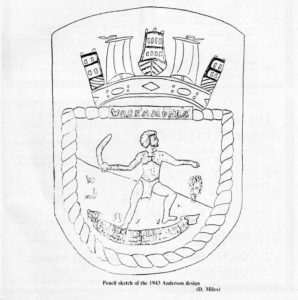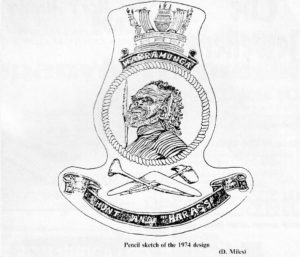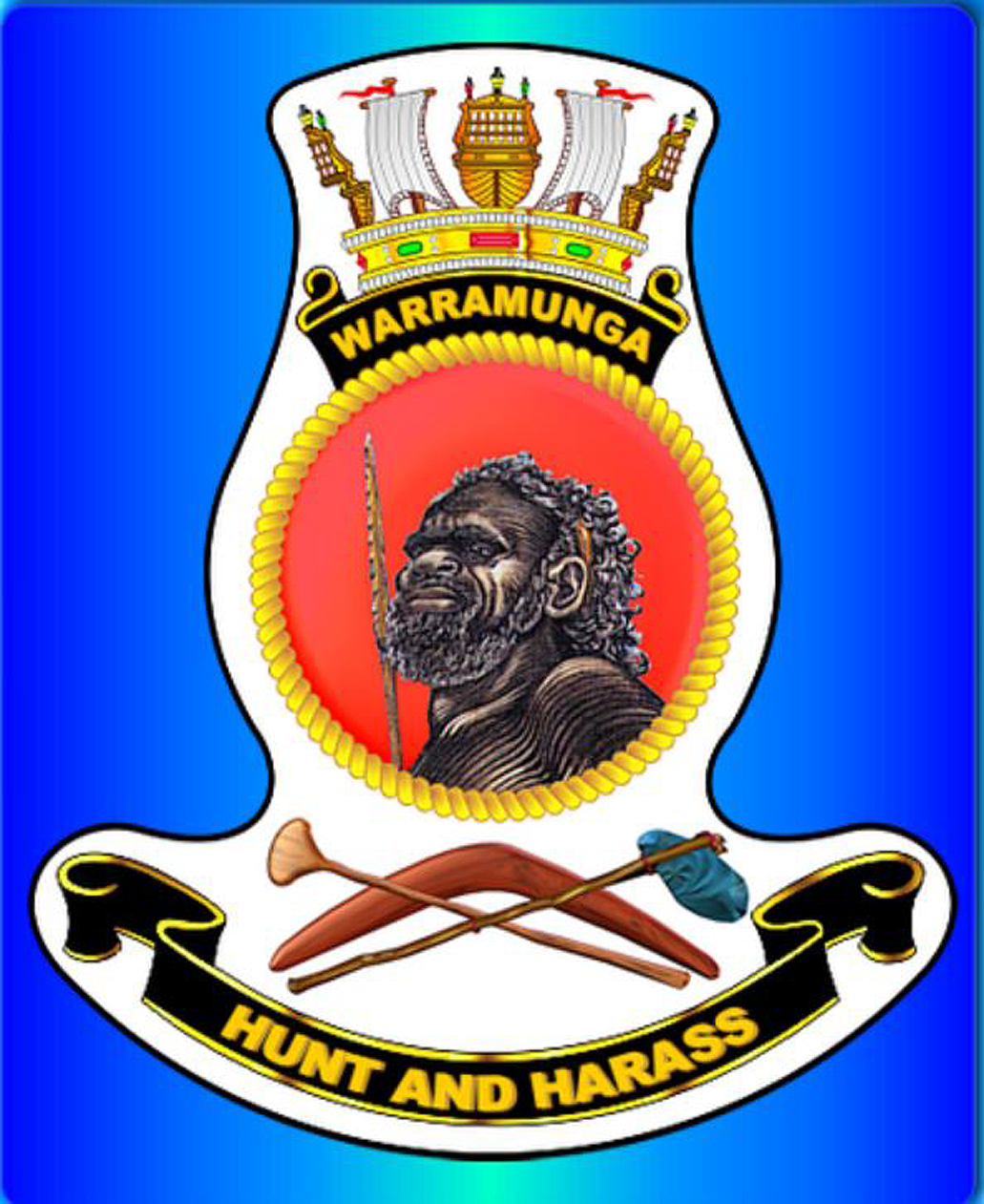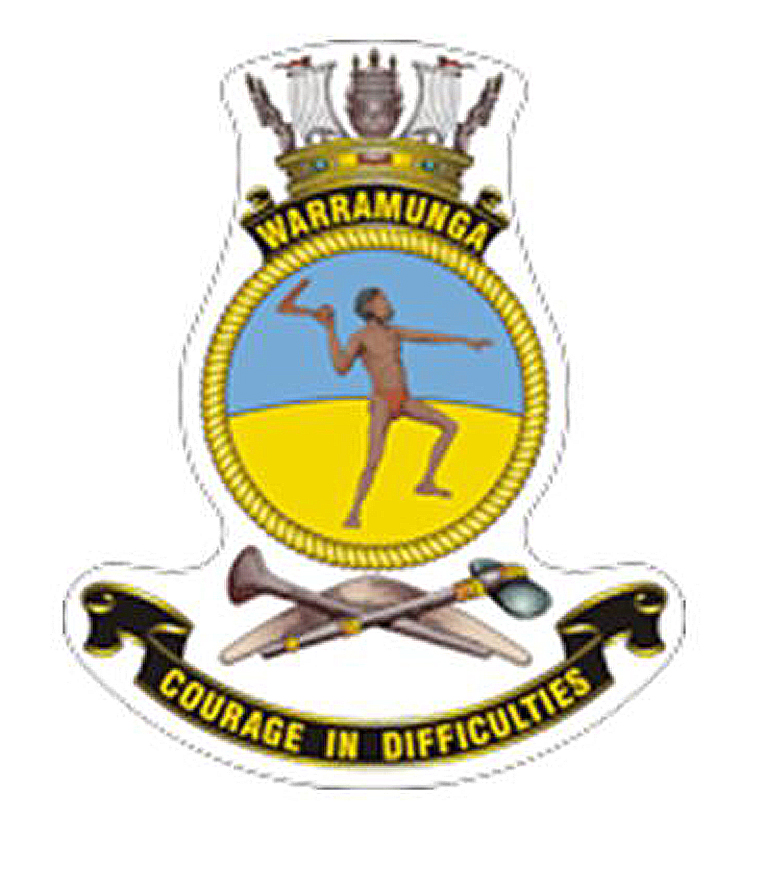- Author
- A.N. Other and NHSA Webmaster
- Subjects
- Ship histories and stories
- Tags
-
- RAN Ships
- HMAS Warramunga I
- Publication
- December 1980 edition of the Naval Historical Review (all rights reserved)
WHEN HMAS WARRAMUNGA commissioned for service in November 1942 no official badge had been authorised for the ship, and being wartime this was of no great consequence. Early in 1943 the commanding officer, Commander E.F.V. Dechaineux, DSC, RAN, held a competition amongst his crew for the design of a suitable badge. The competition was won by Petty Officer Hugh Anderson, who carved out what he considered to be something appropriate to a ship bearing a Tribal name. The winning design was the traditional shield as used for destroyer badges, surmounted by the name of the ship. Above the shield was the usual naval crown. The motif on the shield depicted a Warramunga warrior about to throw a boomerang. Beneath the warrior, but on the shield, was a motto ‘Courage In Difficulties’.

With the captain’s blessing, the badge was adopted by the ship. The US Navy’s destroyer tender Dobbin was in port, so the carving was taken over to see if the Americans could knock up something in the way of a replica of the original wood cut. With their usual efficiency, the Americans cast a badge in brass and this was taken back to Warramunga. As far as ‘The ‘Munga’ was concerned she had a badge and the matter was settled. Due to wartime conditions it now seems that Commander Dechaineux never pursued the matter of his badge competition any further and never advised Navy Office, nor did the next two commanding officers.
At the end of 1945 Commander Max Clark wrote to Navy Board regarding an official badge for the ship. His letter, dated 9th October 1945 states in part ‘With reference to Navy Office letter 66031 dated 24th September 1945, it is submitted that HMA Ship under my command was commissioned without an official badge.’ He goes on to say that a talent quest had been conducted but that no fitting design had been obtained and therefore asked the Naval Board to obtain some professional assistance to have a badge struck.
It would appear from this that Commander Clark was completely unaware of Petty Officer Anderson’s badge and was completely in the dark about the approval given by Commander Dechaineux. Perhaps the matter may have been brought to a happy conclusion had he approached some of the older members of the crew who were fully informed about the unofficial badge. As it was he evidently never saw Petty Officer Anderson’s effort, or if he did he was not prepared to accept it. Whatever the reason. Commander Clark wanted an official badge.
Navy Board acted with promptness, as a letter dated 29th August 1946 merely states that ’. . . the question generally of badges for HMA Ships is under discussion and on a decision being reached a further communication will be addressed to you . . .’ This may see an off-handed approach to the subject, but it must be remembered that there were practically no official badges at all in the RAN. Not one of the 56 AMSs commissioned during the war had an official badge and the same went for the bulk of the fleet.
A design for a ship’s badge for Warramunga was submitted by Captain W.H. Harrington in 1948 and, although it may have been correct as far as heraldry was concerned, it bore no Tribal connection at all. The design showed ‘A sword rising from the sea (light blue) against a dark blue sky.’ According to Harrington, light blue and dark blue were the ship’s colours. The motto was in Latin ‘Pugnare Non Cedere’, meaning to fight and not to yield. This motto was of course a standard one, and possibly had more scholastic merit than Anderson’s ‘Courage in Difficulties’. Captain Harrington also mentioned dark brown boomerangs but gave no indication as to the siting of them on the badge. Perhaps he had in mind the present system of crossed Aboriginal weapons under the motto.
CST FND was the chairman of the Ship’s Badges Committee at this time and maybe he had more on his plate to worry about than ship’s badges because it seems that practically every one of Warramunga’s drivers made a request for an official ship’s badge at some time or other. The last letter in the string of requests to the Ship’s Badge Committee was sent to CST FND from Kure, Japan, dated 24th April 1952, the CO at the time being Commander Ramsey, now Sir James Ramsey, Governor of Queensland. Late in 1952 a reply reached the ship from CST FND stating that the 1948 design was not approved. In this case it seems that CST’s motto was ‘We are always prompt, no matter how long it takes.’
We must remember that Warramunga was fully engaged in WW2, had spent much time on the occupation force in Japan and had served two turns in the Korean conflict, but whilst she had no official badge the old 1943 design was actually used by the ship.
The ship paid off in 1952 and was converted to an anti-submarine escort destroyer. In 1954 she recommissioned under the command of Commander L.M. Hinchliffe, DSC, RAN. The old bogey of an official badge came up again but the ship recommissioned using the 1943 design in the now standard circular badge plate. Designs were called for but by the time the writer left the ship in 1955 there was no sign of a new ship’s badge. In December 1954 Rear- Admiral Dowling wrote to CST FND noting ’It is observed that no badge has been approved for HMAS Warramunga and it is requested that early action be taken in this regard.’ In this case CST FND got down to business straight away, replying on 11th January 1955 to say that no reply had been received from the ship to the request for a new proposal. This is quite understandable considering the difficulties encountered during the commissioning of the ship and the subsequent trials and tribulations that ensued. In fact the old motto of ‘Courage in Difficulties’ was very appropriate at that time.
Finally in August 1955 Commander Purvis, who had relieved Commander Hinchliffe earlier in the year, informed Captain D10 in Tobruk that a badge had been selected, showing a Warramunga warrior holding a barbed spear, with the motto ‘We Hunt We Harass’. This badge was approved on 9th February 1956. ‘The ‘Munga’ now had a badge, officially approved, but an odd point arises in this regard.
Between 29th August and 1st September 1959 HRH Princess Alexandra of Kent was onboard Warramunga for a cruise in the Barrier Reef area and the official programme cover for this cruise features the 1954 Anderson designed badge. This was two years after the new badge had been approved, but someone seemed to have preferred the original design.
There was a lot of criticism of the new badge, the Warramunga warrior being armed with a broad bladed Zulu stabbing spear being one of the main complaints.
The ship paid off in December 1959 and was sold for scrapping in 1962. It would seem that the matter of Warramunga’s badge was a closed file. But, like a Phoenix from the past, in 1974 a re-drawn badge arrived on the scene. This was a much improved version of the 1956 design, the warrior now owning a barbed spear. The 1955 motto ‘We Hunt We Harass’ had been shortened to ‘Hunt And Harass’ when the 1956 approval was given and this was the motto incorporated into the 1974 design. Naturally the new design made no difference to the ship herself, but it would mean that any new ship commissioning with the name of Warramunga would have a badge from the word go.

Feelings about the new badge are mixed, older members of the former ship’s company would have preferred to have retained the 1943 Anderson design and its motto. This fact is borne out by the fact that the HMAS Warramunga Association always uses the original badge. For the sake of tradition, and out of respect for ‘Old Dessie’ Dechaineux, it would be quite in order to simply revert to the use of the badge which it appears the ship herself used throughout her notable career. It was carried with pride and was approved by a very fine Australian gentleman. This whole exercise seems to bear out the old axiom of the right hand not knowing what the left hand was doing. Although the 1943 design was never officially recognised, it was certainly recognised in the ship. The original brass casting now hangs in state in the Belmore RSL Club, where there is quite appropriately a Warramunga Bar. This is the badge that holds very much sentimental value to many ex-Warramunga men, the one cast by the American sailors on the Dobbin for them. It is the badge that protected the ship during her wartime service. It is the badge selected by Captain E.F.V. Dechaineux, who was to lose his life in Leyte Gulf in 1944. It is the badge that was used by the ship during the Royal Visit of Princess Alexandra. Captain Dechaineux is permanently associated with Warramunga, it was his ship. The 1943 designed badge is his everlasting connection with a gallant ship. Let us hope that these facts are taken into consideration if and when a second ship bearing the proud name Warramunga commissions.






